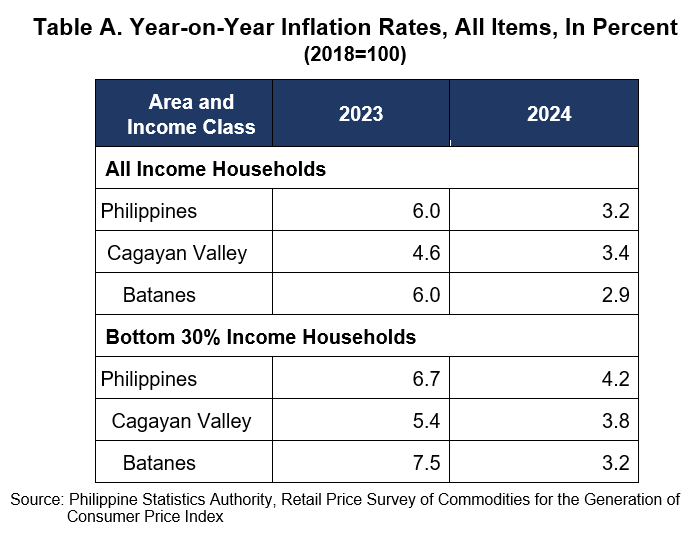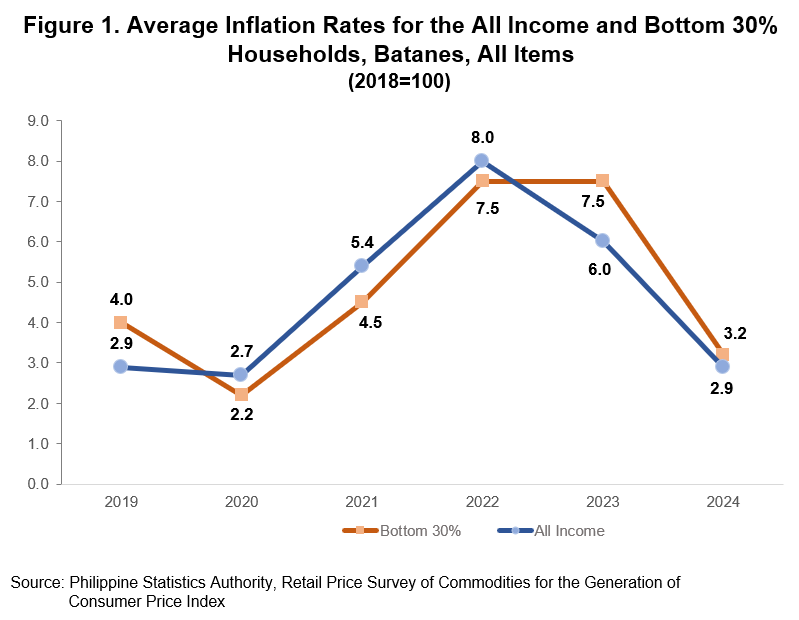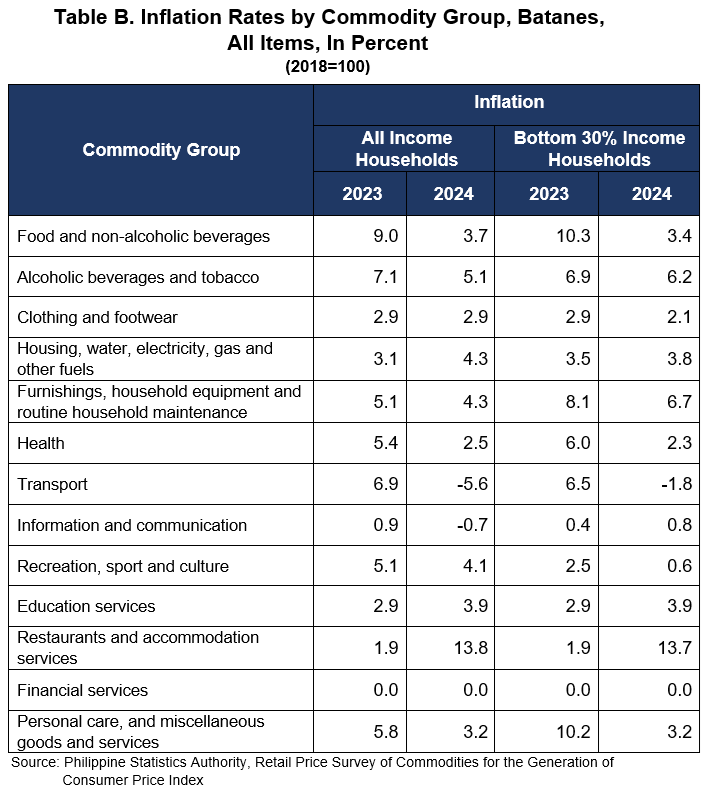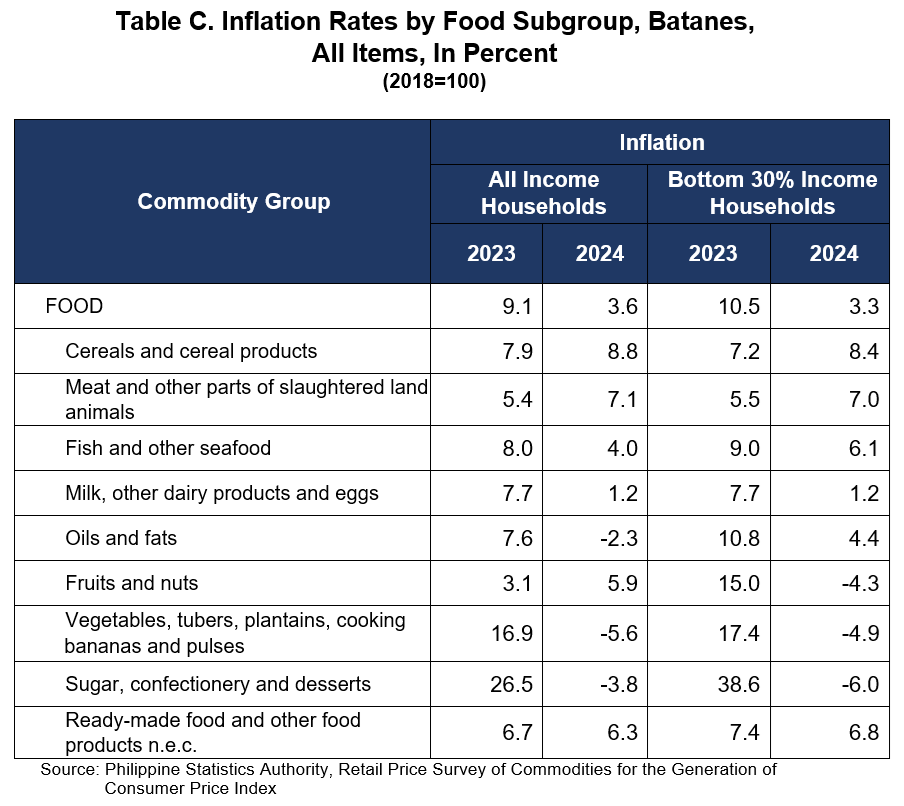
The annual average inflation rate for all income households in the province of Batanes decelerated in 2024 at 2.9 percent from 6.0 percent in 2023. In the region, annual average inflation in Cagayan Valley decelerated to 3.4 percent in 2024 from 4.6 percent in 2023. Nationwide, the inflation decreased to 3.2 percent during the reference year from 6.0 percent in the previous year. (Table A)
For the bottom 30 percent income households, or the household whose per capita income falls below the bottom 30 percent of the cumulative per capita distribution, inflation decelerated at 3.2 percent in 2024 from 7.5 percent in 2023. Meanwhile, the regional and national year-on-year change in price index for the low-income group decelerated from their previous year’s annual rates at 3.8 percent and 4.2 percent, respectively (Table A). Figure 1 shows that the inflation for the bottom 30 percent income household in the province is generally higher than the inflation for all income household for years 2019, 2023, and 2024. This means that the commonly purchased goods and services of the low-income group moved at a faster rate than the commodities in the market basket for all income households for the said years.

The major driver of trend in the province’s average annual inflation for all income households was the lower year-on-year change in the index of transport which decreased from 6.9 percent in 2023 to -5.6 percent in 2024. Other commodity which contributed to the downtrend of this year’s inflation are:
a. Food and non-alcoholic beverages, 3.7 percent;
b. Health, 2.5 percent;
c. Personal care, and miscellaneous goods and services, 3.2 percent
d. Alcoholic beverages and tobacco, 5.1 percent;
e. Information and communication, -0.7 percent,
f. Recreation, sport and culture, 4.1 percent, and
g. Furnishings, household equipment and routine household maintenance, 4.3 percent.

In contrast, restaurants and accommodation services (13.8%); housing, water, electricity, gas and other fuels (4.3%); and education (3.9%) exhibited a faster growth on the year-on-year change in their indices during the reference period. In addition, clothing and footwear maintained its previous year’s average inflation at 2.9 percent. Meanwhile, financial services remained at zero percent annual rate. (Table B)
For the bottom 30 percent income households, the deceleration of annual average inflation was due to the decreased in transportation (-1.8%); personal care, and miscellaneous goods and services (3.2%); food and non-alcoholic beverages (3.4%); health (2.3%); recreation, sport and culture (0.6%); furnishings, household equipment and routine household maintenance (6.7%); clothing and footwear (2.1%); and alcoholic beverages and tobacco (6.2%). (Table B)

Average inflation for food for all income households decelerated to 3.6 percent during the reference year from 9.1 percent in the previous year. Average food inflation for the low-income group also decelerated in 2024 to 3.3 percent from 10.5 percent in 2023. (Table C)
The main drivers of the lower average inflation for food for all income households are the decreased in the annual growth of indices in the food groups: sugar, confectionery and desserts (-3.8%); vegetables, tubers, plantains, cooking bananas and pulses (-5.6%); and oils and fats (-2.3%)
For the bottom 30 percent households, the main drivers were the lower inflation of sugar, confectionery and desserts (-6.0%); vegetables, tubers, plantains, cooking bananas and pulses (-4.9%); and fruits and nuts(-4.3%).
Note:
CPIs and inflation rates by province and selected city are posted at the PSA website (https://www.psa.gov.ph/).
RAMIL G. ABAD
Chief Statistical Specialist
PSA-Batanes
